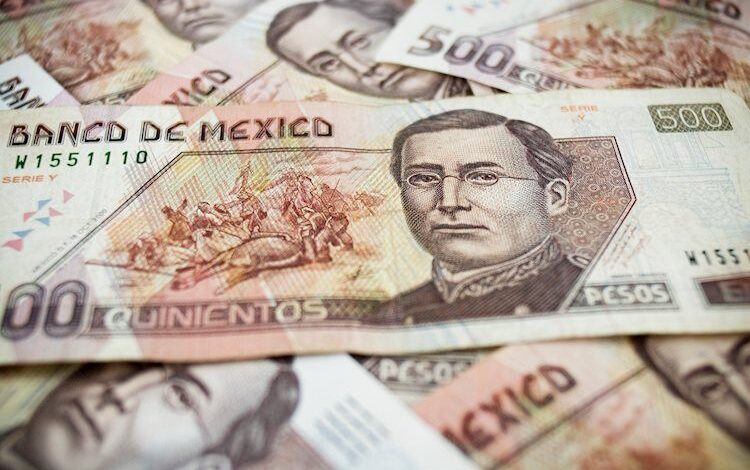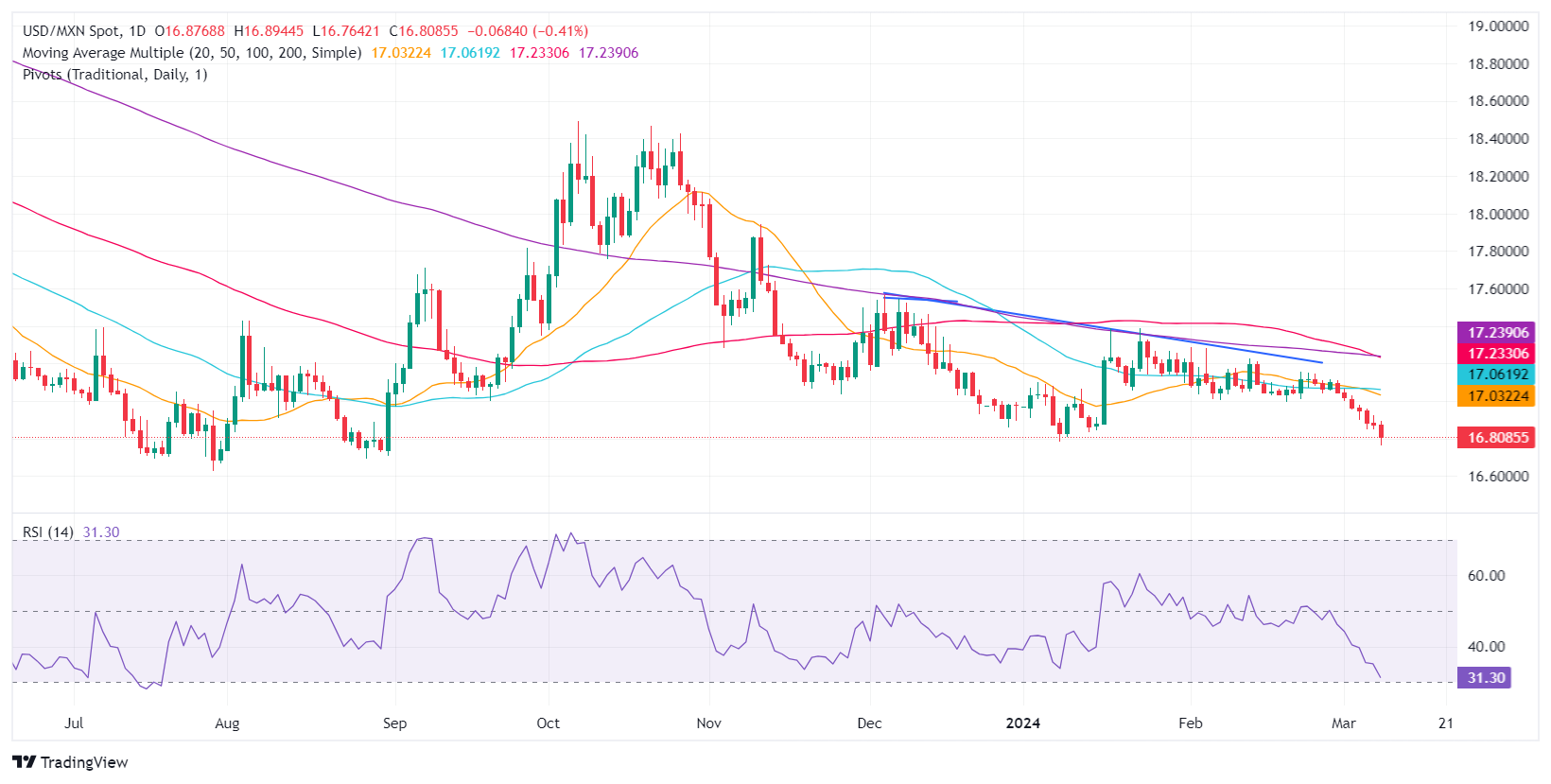Mexican Peso advances sharply as US Dollar tumbles to seven-week low

- Mexican Peso appreciates for the seventh consecutive day, buoyed by soft US Dollar following mixed US jobs report.
- Banxico’s upcoming rate decision eyed closely after subdued Mexican inflation figures.
- US Nonfarm Payrolls exceed expectations, but revisions and higher Unemployment Rate fuel speculation of June Fed rate cut.
The Mexican Peso appreciated for the seventh straight day on Friday against the US Dollar following a mixed jobs report from the United States that increased speculation that the US Federal Reserve (Fed) would cut interest rates in June. The data pushed the Greenback to seven-week lows, a tailwind for the emerging market currency that is set to finish the week with gains of more than 0.20%. The USD/MXN trades at 16.81, down 0.31%, and is set to wrap the week with more than 1.21% losses.
Mexico’s economic docket is empty on Friday, but data revealed during the week could influence the Bank of Mexico (Banxico) decision on March 21. Gross Fixed Investment remained flat on monthly figures but contracted for the 12 months to December, while Consumer Confidence was unchanged. However, Thursday’s inflation data was the main spotlight, with the Consumer Price Index (CPI) lower than expected on monthly and annual figures, while core CPI was mixed.
On the other side of the border, the US Bureau of Labor Statistics (BLS) revealed a mixed US Nonfarm Payrolls (NFP) report. Although the US economy added more jobs than expected, the BLS downwardly revised January’s figures, while the Unemployment Rate jumped close to the 4% threshold.
Daily digest market movers: Mexican Peso boosted by broad US Dollar weakness
- US Nonfarm Payrolls in February were higher than the consensus of 200K and rose by 275K. January’s figures were revised down to 229K from 353K. Further data underscored that the jobs market is cooling as the Unemployment Rate increased from 3.7% to 3.9%, while Average Hourly Earnings edged lower in monthly and annual figures.
- Earlier, New York Fed President John Williams said that the Fed’s tight monetary policy has moderated demand, emphasizing the Fed’s dedication to price stability. He stressed that the Fed’s decisions are independent of politics and remarked on the economy’s strong performance in 2023.
- Mexican economic data released in the week:
- Mexico’s inflation was 4.40% YoY, below estimates of 4.42% and January’s 4.88%. On a monthly basis, CPI was down from 0.11% to 0.09%.
- The Core CPI rose by 4.64% above forecasts but lower than the previous reading of 4.76%, while monthly figures were aligned with estimates of 0.49%, up from 0.40%.
- Mexico’s consumer confidence index was 47.0 in February when adjusted for seasonal factors. The unadjusted index was 47.1.
- Mexico’s Gross Fixed Investment remained flat in December. Nevertheless, on an annual basis, it dipped from 19.2% to 13.4%.
- A Reuters poll sees the Mexican Peso depreciating 7% to 18.24 in 12 months from 16.96 on Monday, according to the median of 20 FX strategists polled between March 1-4. The forecast ranged from 15.50 to 19.00.
- A Reuters poll shows 15 analysts estimate that inflation will slow down in February, corroborating bets that the Bank of Mexico (Banxico) could cut rates as soon as the March 21 meeting.
- Banxico’s private analysts’ poll projections for February were revealed. They expect inflation at 4.10%, core CPI at 4.06%, and the economy to grow by 2.40%, unchanged from January. Regarding monetary policy, they see Banxico lowering rates to 9.50% and the USD/MXN exchange rate at 18.31, down from 18.50.
- During Banxico’s quarterly report, policymakers acknowledged the progress on inflation and urged caution against premature interest rate cuts. Governor Victoria Rodriguez Ceja said adjustments would be gradual, while Deputy Governors Galia Borja and Jonathan Heath called for prudence. The latter specifically warned against the risks of an early rate cut.
- Banxico updated its economic growth projections for 2024 from 3.0% to 2.8% YoY and maintained 1.5% for 2025. The slowdown is blamed on higher interest rates at 11.25%, which sparked a shift in three of the five governors of the Mexican Central Bank, who are eyeing the first rate cut at the March 21 meeting.
- The political race is almost defined in the United States after Super Tuesday. Former President Donald Trump leads the Republicans with 995 delegates, shy of the 1,215 needed. On the Democratic side, US President Joe Biden leads with 1,497 delegates, short of the 1,968 needed.
- The CME FedWatch Tool shows traders increased their bets for a 25-basis-point rate cut in June from 52.7% a week ago to 78%.
Technical analysis: Mexican Peso posts solid rally as USD/MXN hovers around 16.80
The USD/MXN downtrend remains in play after breaching below 17.90, printing a new yearly low of 16.76. However, sellers need to achieve a daily close below 16.80 if they would like to test the 2023 yearly low of 16.62. Once that barrier is surpassed, look for October 2015’s low of 16.32 and the 16.00 threshold.
On the other hand, if buyers reclaim the 17.00 figure, that could open the door to testing the 50-day Simple Moving Average (SMA) at 17.05, followed by the 200-day SMA at 17.23 and the 100-SMA at 17.24.
USD/MXN Price Action – Daily Chart
Mexican Peso FAQs
The Mexican Peso (MXN) is the most traded currency among its Latin American peers. Its value is broadly determined by the performance of the Mexican economy, the country’s central bank’s policy, the amount of foreign investment in the country and even the levels of remittances sent by Mexicans who live abroad, particularly in the United States. Geopolitical trends can also move MXN: for example, the process of nearshoring – or the decision by some firms to relocate manufacturing capacity and supply chains closer to their home countries – is also seen as a catalyst for the Mexican currency as the country is considered a key manufacturing hub in the American continent. Another catalyst for MXN is Oil prices as Mexico is a key exporter of the commodity.
The main objective of Mexico’s central bank, also known as Banxico, is to maintain inflation at low and stable levels (at or close to its target of 3%, the midpoint in a tolerance band of between 2% and 4%). To this end, the bank sets an appropriate level of interest rates. When inflation is too high, Banxico will attempt to tame it by raising interest rates, making it more expensive for households and businesses to borrow money, thus cooling demand and the overall economy. Higher interest rates are generally positive for the Mexican Peso (MXN) as they lead to higher yields, making the country a more attractive place for investors. On the contrary, lower interest rates tend to weaken MXN.
Macroeconomic data releases are key to assess the state of the economy and can have an impact on the Mexican Peso (MXN) valuation. A strong Mexican economy, based on high economic growth, low unemployment and high confidence is good for MXN. Not only does it attract more foreign investment but it may encourage the Bank of Mexico (Banxico) to increase interest rates, particularly if this strength comes together with elevated inflation. However, if economic data is weak, MXN is likely to depreciate.
As an emerging-market currency, the Mexican Peso (MXN) tends to strive during risk-on periods, or when investors perceive that broader market risks are low and thus are eager to engage with investments that carry a higher risk. Conversely, MXN tends to weaken at times of market turbulence or economic uncertainty as investors tend to sell higher-risk assets and flee to the more-stable safe havens.
Information on these pages contains forward-looking statements that involve risks and uncertainties. Markets and instruments profiled on this page are for informational purposes only and should not in any way come across as a recommendation to buy or sell in these assets. You should do your own thorough research before making any investment decisions. FXStreet does not in any way guarantee that this information is free from mistakes, errors, or material misstatements. It also does not guarantee that this information is of a timely nature. Investing in Open Markets involves a great deal of risk, including the loss of all or a portion of your investment, as well as emotional distress. All risks, losses and costs associated with investing, including total loss of principal, are your responsibility. The views and opinions expressed in this article are those of the authors and do not necessarily reflect the official policy or position of FXStreet nor its advertisers. The author will not be held responsible for information that is found at the end of links posted on this page.
If not otherwise explicitly mentioned in the body of the article, at the time of writing, the author has no position in any stock mentioned in this article and no business relationship with any company mentioned. The author has not received compensation for writing this article, other than from FXStreet.
FXStreet and the author do not provide personalized recommendations. The author makes no representations as to the accuracy, completeness, or suitability of this information. FXStreet and the author will not be liable for any errors, omissions or any losses, injuries or damages arising from this information and its display or use. Errors and omissions excepted.
The author and FXStreet are not registered investment advisors and nothing in this article is intended to be investment advice.




